Here is the full passage report of our sail to Porto Santo from mainland Portugal.
On a sunny Saturday morning, we raised the main, and turned away from mainland Portugal. Our destination: Porto Santo, part of the Madeira archipelago, 435nm away.
The sea was flat calm in the Enseada de Sagres, where we had spent the night. However, once we cleared Cabo Sagres – the headland that holds Henry the Navigator’s fort – we met a light swell and stronger wind from the north. We unfurled the foresail, and silenced the engine. Emerald was now sailing on a course roughly west-south-west, which we would maintain the whole way across.
To help us with the passage we had a third crew member onboard – Harry the Hydrovane. After a little bit of adjustment, it steered us all the way to Porto Santo.
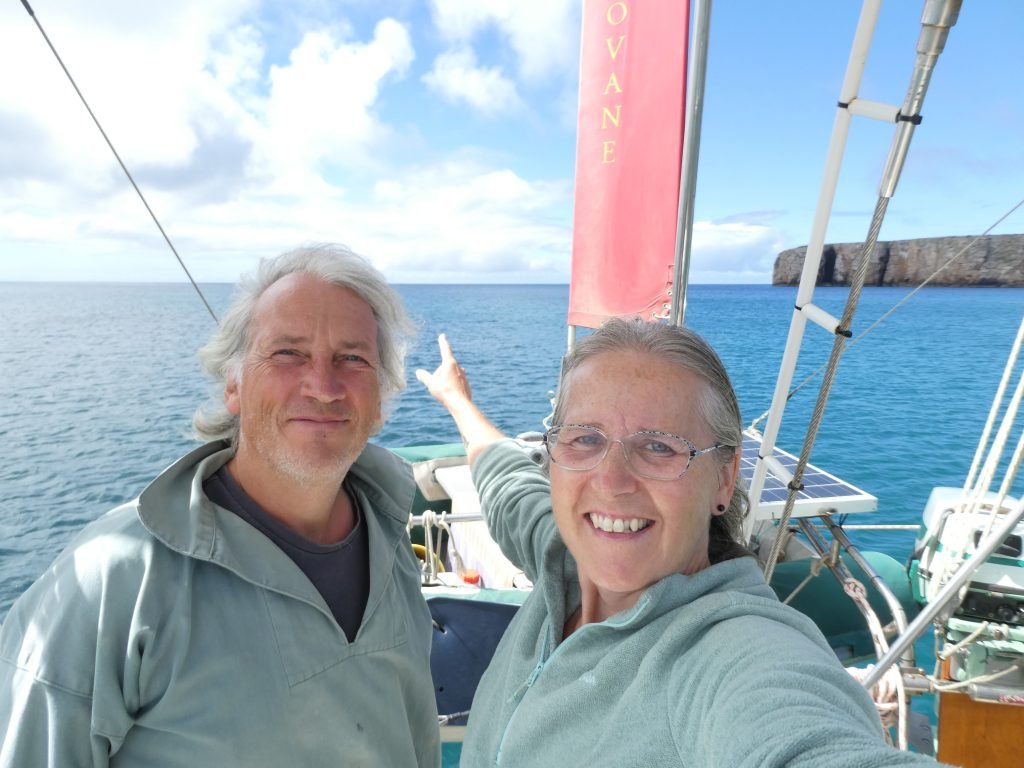
The Shipping Lanes
Our first waypoint was at the start of the shipping lanes that curve around Cape St. Vincent. The lanes are used to organise shipping in sensitive or busy areas, to reduce the risk of an accident. There are four lanes: two for east going ships and two for west. Each direction has a lane for normal cargo ships and another for sensitive cargo such as gas and oil tankers.
Sailboats don’t need to use the lanes, but to cross them, they should do so at 90 degrees to the lanes. It just so happened that our course was at 90 degrees to them anyway, so it didn’t take us out of our way.
The first lane was for the west going ships. We kept a visual look out, using the AIS to provide additional information such as ship speed. It wasn’t busy, only one ship crossed ahead of us and another behind. As we crossed the wind increased and by the time we left the final lane, we had two reefs in the main and a heavily furled foresail. The wind was around 25kts, gusting a little higher.
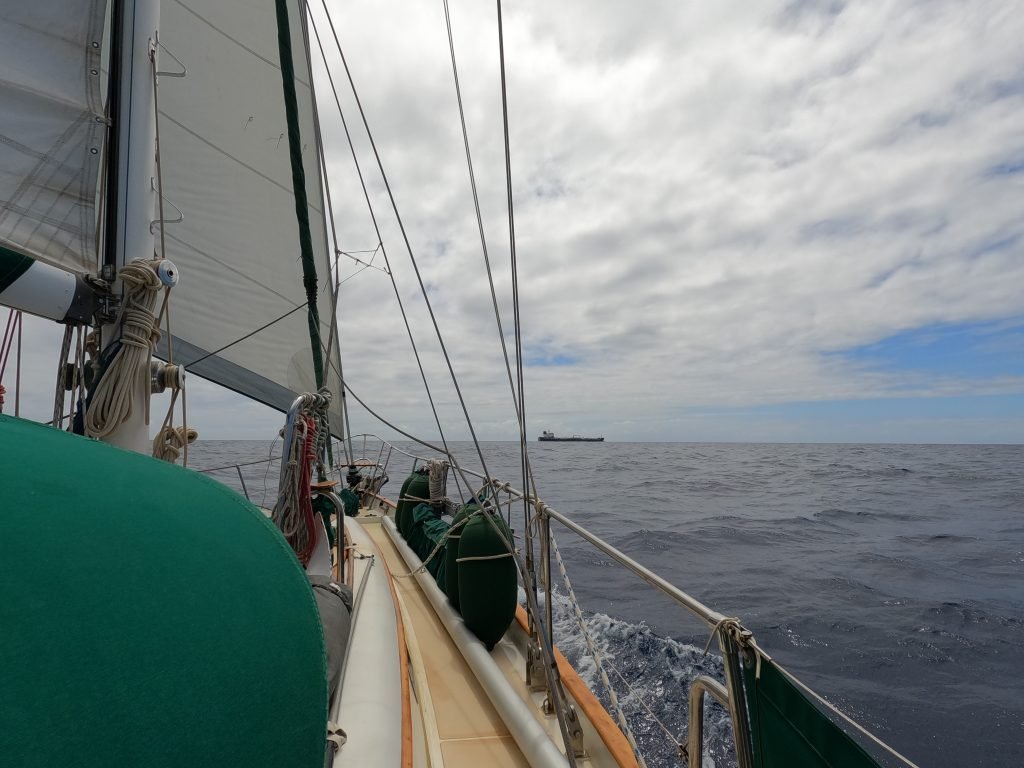
A Bouncy First Night at Sea
Just before darkness arrived, the wind and sea state increased even more. We put a third reef in with the wind at a steady F6 (25 to 30 kts) with stronger gusts. Despite being a heavy yacht further weighed down with all our “stuff”, we were maintaining a Speed Over Ground (SOG) of over 6kts, occasionally over 7kts. Due to the motion on board it wasn’t easy to do everyday tasks. We decided against warming up the pre-cooked curry for tea and plumped for Soreen and Cup-A-Soup instead. And lots of chocolate.
We also decided to sleep up in the cockpit as inside was just too uncomfortable. Our watch system reduced from 3 hours to a maximum of 2, and off watch we napped. Now it was dark, we couldn’t see the bigger waves which seemed to come from two directions. Emerald was picked up and twisted around, which occasionally threw the Hydrovane off. The on-watch person’s job was to correct the helm after one of these twists. It was definitely not fun. During one of my watches I wondered if this would be life for the next three days. And how could people keep this up for much longer passages?
It was a chilly night, and the occasional wave splashes that invaded the cockpit, giving us an unexpected soaking, didn’t help. Although it seemed longer, thankfully there were only 7 hours of darkness. However, the dark was properly dark, with no moon and clouds obscuring much of the star light. But as dawn arrived and the sky imperceptibly lightened behind us, my spirits slowly rose. It was a spectacular sunrise, and the gentle heat that the rising sun brought was a balm.
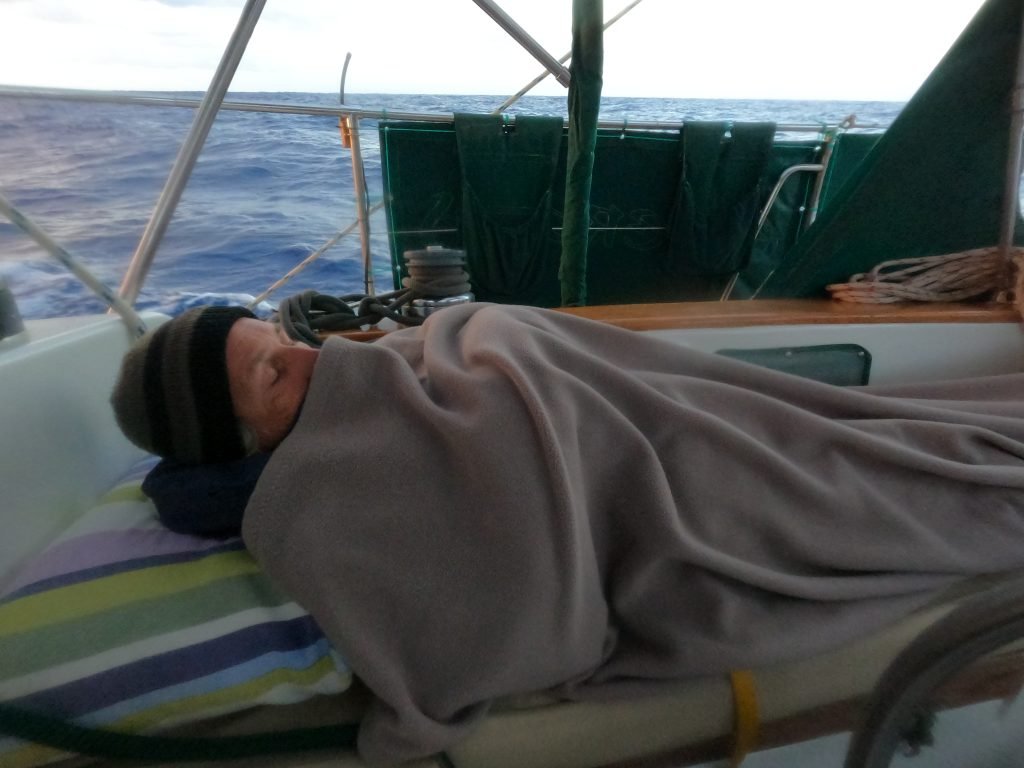
Day Two of the Sail to Porto Santo
Come morning, we could now clearly see the sea state. We guessed at at least a 2m wave height, with chop on top. However, with the daylight, we could now pre-empt the waves rather than being thrown unexpectedly about. Thankfully, as the hours ticked on, both the wind and the seas eased, and we were able to catch up on some sleep. The motion down below was much more settled and we ate half of the prepared curry for lunch. The morning gloom had dissipated leaving blue sky dotted with white fluff, and there was some welcome heat from the sun.
Our 24 hour distance was 148nm, much better than we’d estimated. If we kept this up, we’d be there in 3 days.
The wind remained fairly constant through the day, always from the north. 15 to 20 kts was comfortable, but then we got gustier periods of up to 25kts. The sea was more settled with waves now coming from a single direction.
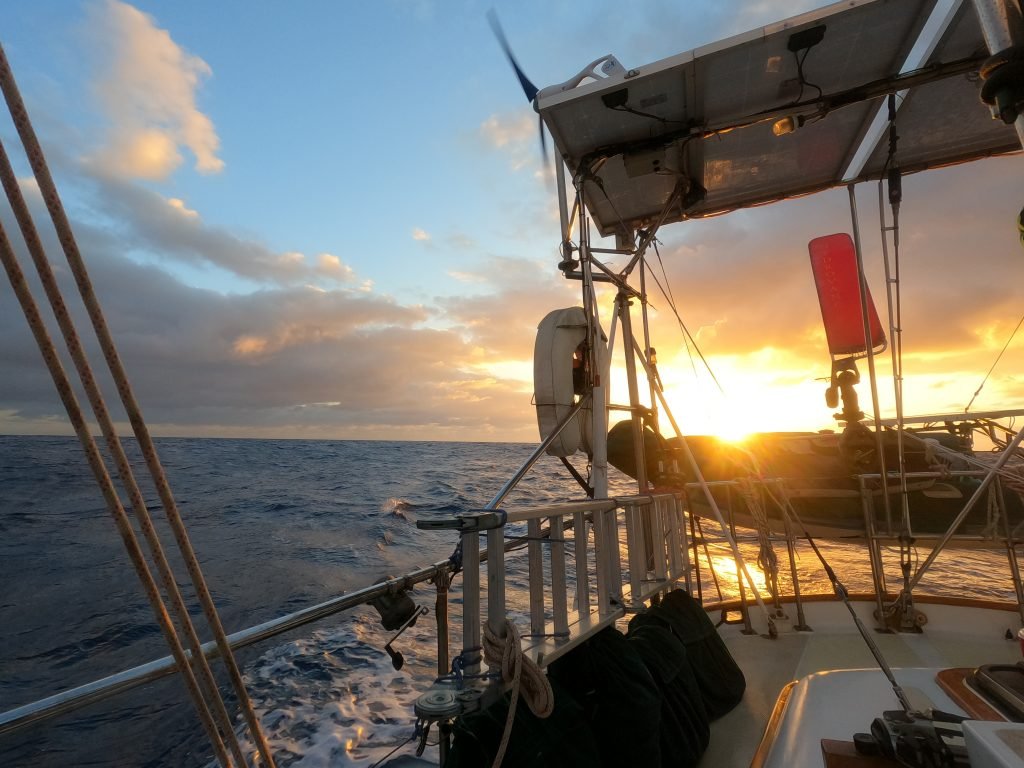
Night Two
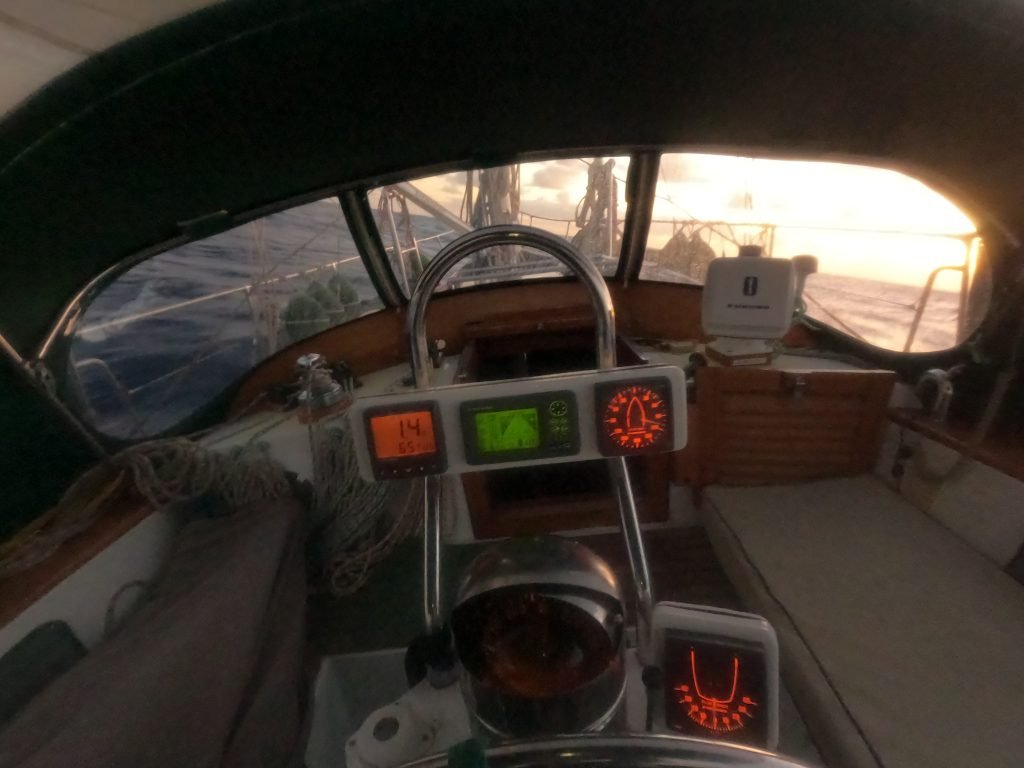
With my seasickness quashed, I decided to sleep inside for night two as outside was just too uncomfortable. However, of course the wind chose to increase and was gusting to 35kts. We still had 3 reefs in the main and just a scrap of foresail. Emerald took it in her stride and bounded along but I was regularly thrown against the lee cloth on our sea berth, leading to a night without much decent rest.
Day Three
Day three was definitely the best of the passage. Whether this was because we knew the finish was near or whether we were finding our rhythm, I don’t know. Perhaps a combination of the two.
On the third night I felt fully awake and alert during my two night watches, having caught up some sleep during the day. We were eating properly, with the prepared food divided into two warm meals a day.
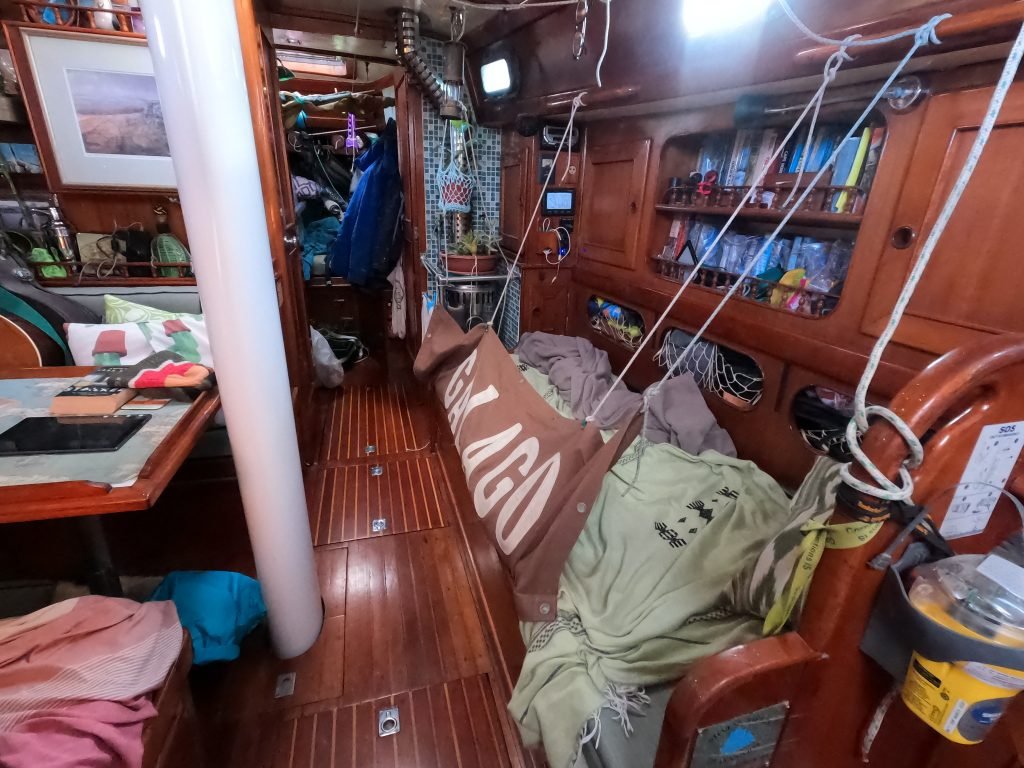
The Last Day
I swapped with Colin just before sunrise on our last day at sea. I’d hoped to see the lights of the island by now, but we still had nearly 40nm to go. I headed inside for a sleep, hoping for it to have come into visual range by the time I woke.
It was a cloudy morning, and the winds had settled around 15kts. During the previous day there had been more east to them. We tried to keep the wind angle with the boat to less than 150 degrees. Otherwise we’d be on a run, and the motion would be much more rolly. But to maintain this angle meant we had been sailing slightly off course. Colin had managed to claw some of this back during his watch, but come morning, the wind was still resolutely NE.
I went off for a sleep and when I woke, there was the island looking dark against the grey sky. We had a few spots of rain, but we were just about managing to hold our course. Maybe there was some current pushing us south.
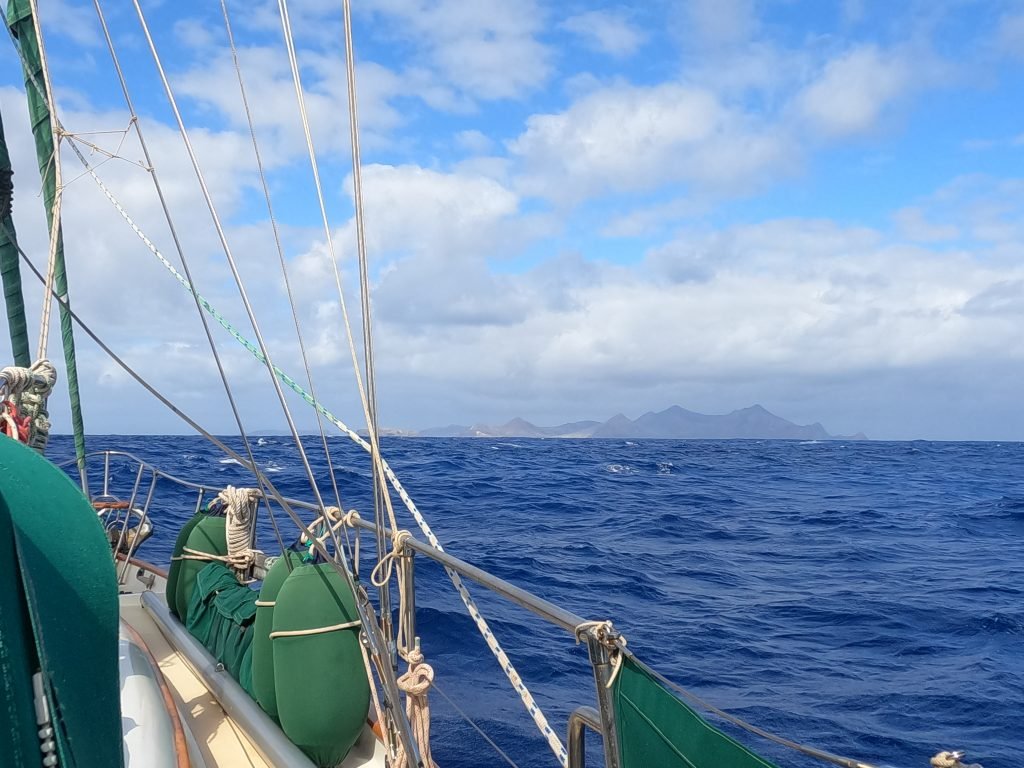
Starting the Engine
A few miles off, we rolled away the foresail, and turned downwind to clear Ilheu de Cima, the island at the eastern end of Porto Santo. We also decided to try and start the engine. Colin went below to do the pre-start checks and I turned the starter key in the cockpit. There was a click, but nothing else. We tried again, with the same result. Colin checked the oil again, and registered that it was higher on the dipstick than it should be, but put this down to the movement during the passage.
With a few other tests and checks complete, we tried again, but the engine refused to start.
The Engine Won’t Start
So, we had no engine. The winds were still in our favour, blowing a F4 from the NE. We were sailing slowly, but in the right direction to clear the island.
Adrenaline spiked and chased away our tiredness. What to do? We studied the charts – the anchorage outside the harbour is large and with the wind direction, we should be able to sail in to it. If we couldn’t we’d have to bear away and continue sailing on to Madeira where we could call for a tow. So we weren’t in any immediate danger and had options, which was a positive. The choice to make right now was – call for help or sail in ourselves. We talked through both options, and chose to hold off on calling for help. After all we weren’t in any immediate danger and had a viable plan to get to the anchorage.
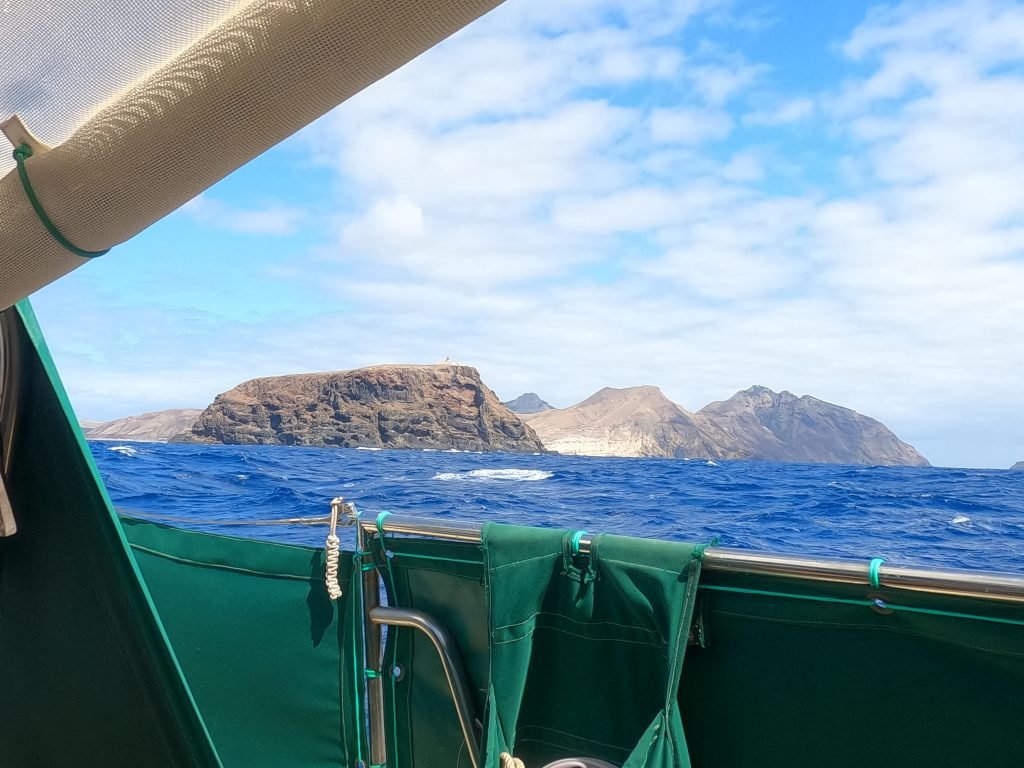
Sailing into the Anchorage
As we turned into the bay of the island, we got a good view of where we needed to go. It certainly looked like a good option to sail in, as there were only 3 other yachts in an area at least 1nm wide.
Our issue was that as we turned towards the beach, we lost the wind under the shelter of the hills. Emerald was slowing down, her SOG down to 2kts. With nerves stretched taut, all we wanted was to get into shallower water and get the anchor down. The slow speed was like torture. We were in 20m of water, so if necessary we could drop the anchor, launch the dinghy and tow ourselves in, but just a little bit more wind would be much better.
As we passed the gap between the islands a welcome gust of wind filled the sail and gave Emerald a much needed push. It faded away, leaving us anxiously watching the flat water, looking for the ripples that signalled a new gust was on its way. When we saw one we called out, “Wind, wind!”. I’ve never been so excited over a little bit of wind!
In slow, excruciating time, we made it to the anchorage area outside the harbour. Emerald drifted to a stand still in 9m of water and I dropped the main whilst Colin went up forward. Having lowered the anchor, a well timed gust helped set it and we had a big hug. We’d never sailed into an anchorage before.
Sail to Porto Santo: Passage Complete
We completed the sail to Porto Santo in 3 days, 1 hour and 45 minutes, with an average speed of 6kts. Much faster than anticipated, that mostly being down to the strong winds. We also felt Emerald’s newly smoothed and Coppercoated hull would have helped her speed through the water.
However, suffice to say, our celebrations were muted. Yay, we’d just sailed our longest passage yet and safely arrived at a speck of rock in the Atlantic! Boo, the engine was dead! But yay, we just sailed into the anchorage for the first time! Boo, we had an engine to diagnose with potentially a costly fix. It seemed very unfair after all the issues we’d had in the boatyard.
The stress, the relief, the lack of sleep all added up to emotions that were all over the place. We decided to leave the engine until tomorrow, as a good night’s sleep would leave us with clearer heads. And, wow, did we sleep well that night.
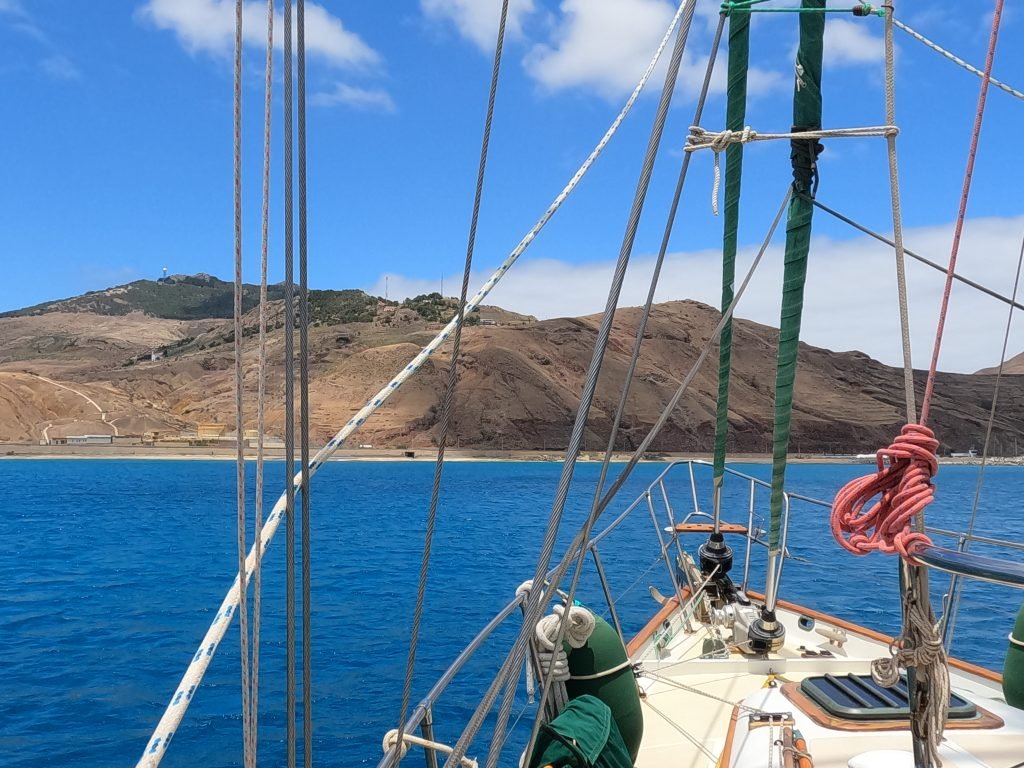
Life On Passage
As mentioned before, our sail to Porto Santo was our longest to date. We usually do a couple of overnight passages a year, and the Ionian to Sicily is two nights. One night is never enough to get into a rhythm, so this passage would be interesting to see how we felt with the extra distance.
Sea Sickness
At the start of a sailing season, I typically suffer from seasickness. The seas on the first night even made Colin feel queasy, and he normally doesn’t have a problem.
I usually take Stugeron tablets, chosen after lots of testing of other brands during my scuba diving days. However, sometimes it’s a toss up between which is worse: the seasickness or the effects the pills have. First there’s a dry, horrid mouth that any amount of drinking doesn’t get rid of. Next is a sleepiness that ranges from must-sleep-now to a feeling of being completely out of it.
A friend had given me some patches to try and highly recommended them. I’d tried other methods such as ginger, blocking up one ear, but none of those had worked. I was willing to give the patches a go, especially as they contain only natural ingredients and no nasty chemicals.
On the first day I felt fine in the cockpit, but if I stayed below for more than a few minutes I started to feel the first signs of queasiness. So, it was a quick dash to the loo, update the log then back up top. But by day two, I was able to sit below, look at the laptop screen and even write emails. I sat looking at the screen for around 20 minutes, with no ill feeling at all. Even just looking at a screen inside in the past would have had me running instantly for a bucket. I was amazed.
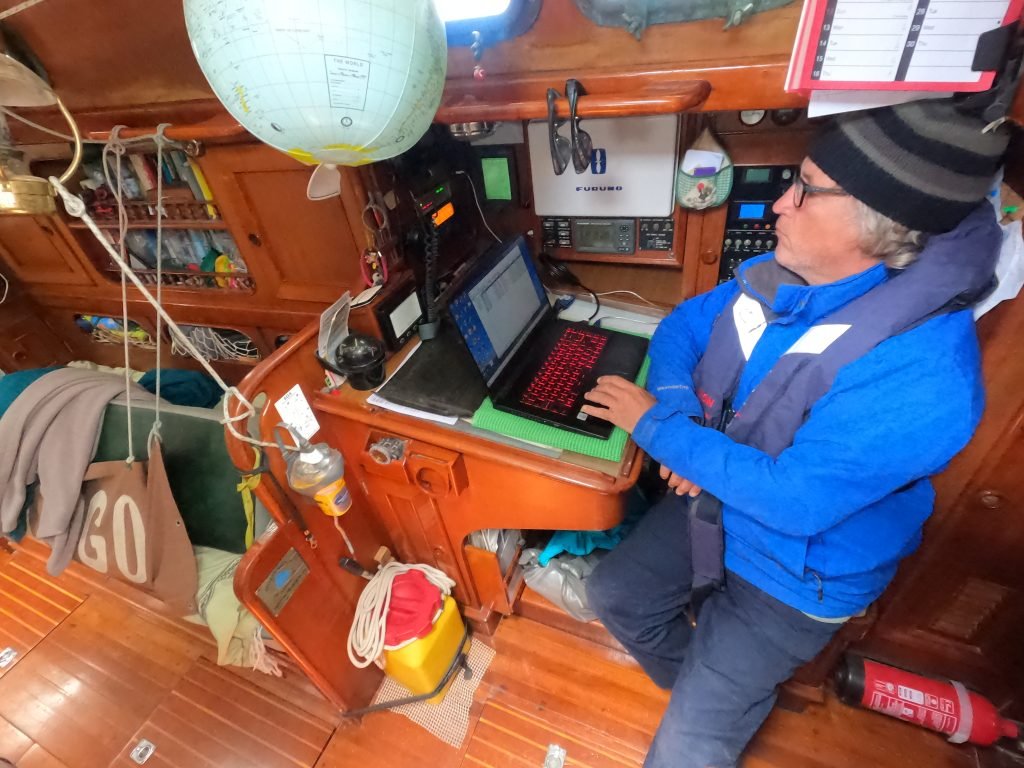
Night Time
We typically run our watch system in periods of 3 hours, between the hours of 10pm and 10am. During the day we’re more flexible and sleep as much as each of us needs. However, that all went out of the window on the first night. We aimed for 2 hour periods, but with the rule that if one of us was struggling, we’d swap sooner.
We had darkness for around 7 hours: from about 10pm to 5am. It was dark-dark too, with no sight of the moon on any of the three nights.
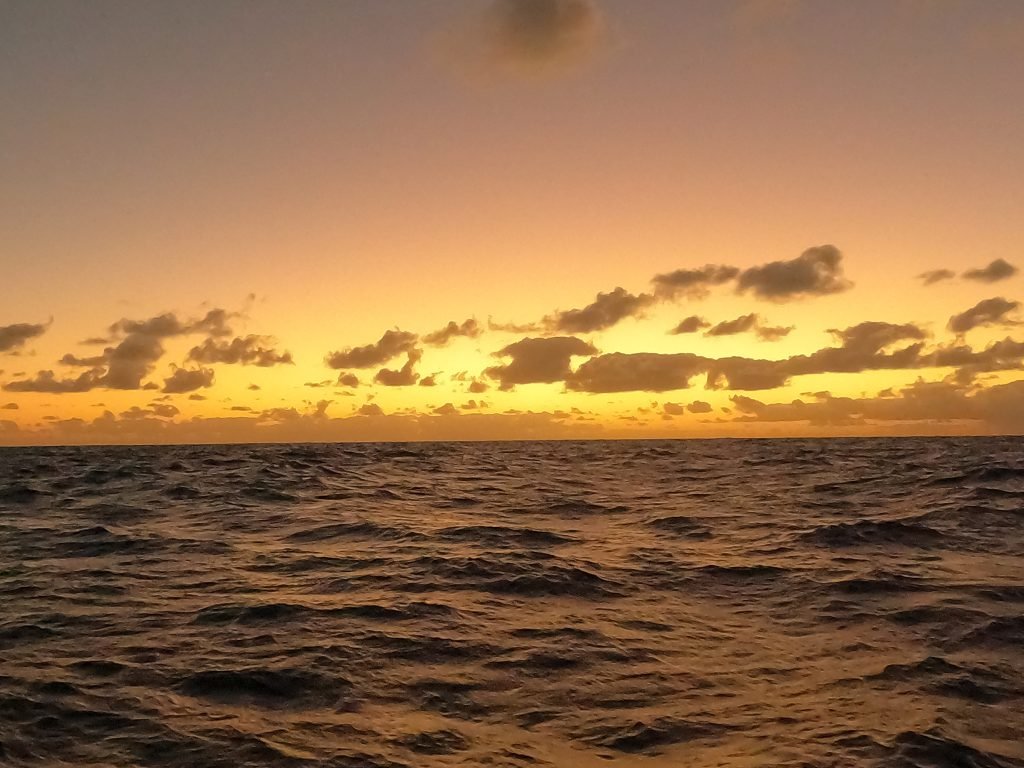
Sing Along
The first night was long and tough, but having had a good night’s sleep before we left, we had some sleep credits to hand. However, by the second night these credits were all used up and keeping awake was a struggle. During one watch, I sang quietly to myself, going through all the songs whose lyrics I could remember. Despite this, there were several moments when my eyes would involuntarily close and the head nod forward then jolted me awake.
No Time to Relax
During the night passages we’ve done in the past, I passed the on-watch time sat in the forward corner of the cockpit, tucked under the sprayhood. There I could read or do puzzles, making regular checks on the instruments and looking out for other ships. In anticipation of this, I’d downloaded a couple of new books, prepared some puzzles and had plans to catch up with my writing. However, it just didn’t happen. During our off watch we were sleeping, eating or doing other tasks. We spent the on-watch time at the helm. Sometimes we’d be hanging on, but mostly checking on our course and correcting if a big wave threw us off.
So Much Sitting
I am a very active person, and there often isn’t a day goes by where I won’t be walking, running or swimming. One of the biggest obstacles of a long passage in my mind is not being able to get this exercise. As expected, there was an awful lot of sitting on this passage. Even though moving around the boat provided a good workout, those periods were brief and I definitely had itchy feet. To help quash my restlessness, I did squats and calf raises during the calmer moments on the helm.
Food
Emerald has a large freezer onboard, giving us the advantage of being able to pre-prepare meals. We had two meals made this way, and a third cooked the day before departure and kept in the fridge.
There was also plenty of backup snacks including high energy foods such as Soreen, protein bars and nuts. Then there was the comfort food which for us is chocolate and crisps.
It was quite a cool passage temperature wise, so we drank plenty of cups of tea, hot chocolate and cup-a-soups to help keep us warm.
Harry the Hydrovane, Our Third Crew Member
Normally we use a Simrad auto pilot to steer on passage. But it was way past time that we should try the Hydrovane. It has a fabric vane whose edge we set to the wind direction and a rudder hung below that then steers the boat. Having set up the rudder and vane the day before we left, it simply needed the locking pins removing to put it into use. We did this just after departure and the Hydrovane steered us all the way across.
We ran the control line to behind the cockpit so that we could adjust for changes in the wind direction without having to venture onto the back deck. There was a learning curve, although not a steep one. This mostly involved determining how much to pull the line to move the vane and balance the boat with our sail plan.
We’ll write more about the Hydrovane in another blog.
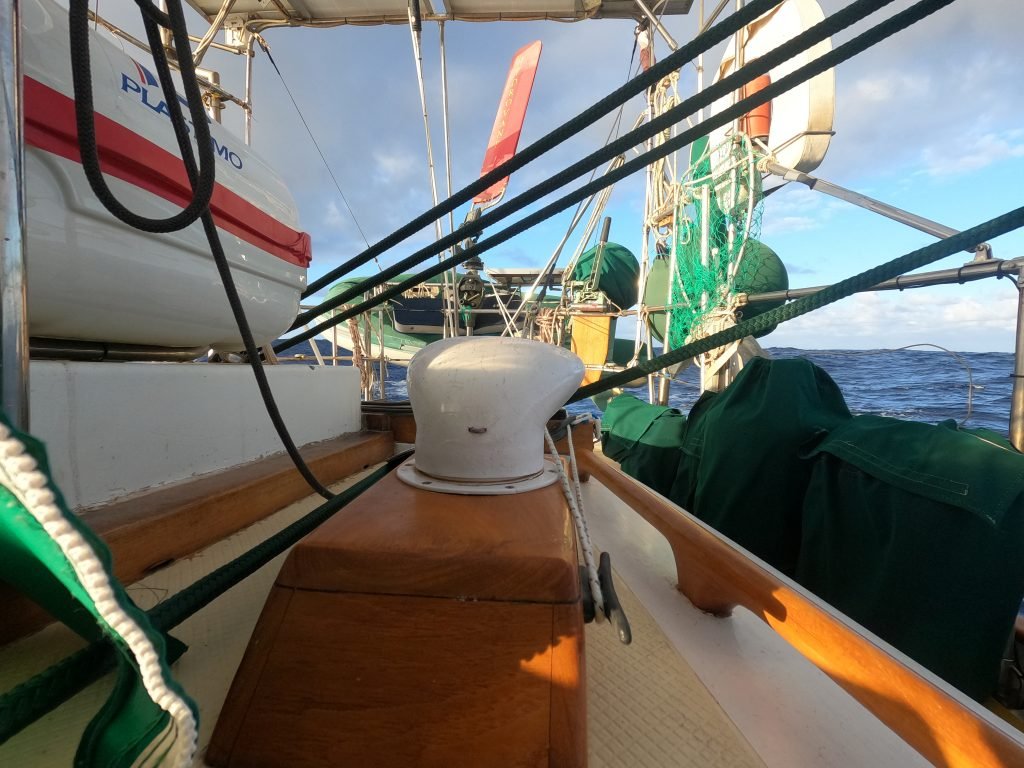
Clothing
We set off in shorts but were soon swapping them for long trousers. We wear clothing designed for hiking as it tends to be lightweight, comfortable and dries quickly. This last point was particularly important when the wave splashes invaded the cockpit.
I even donned my winter “Extremities” socks, although I did wear them with sandals! We donned woolly hats and windproof jackets during the night.
For safety, we wore our heavy duty lifejackets other than when sleeping below and clipped on to safety lines when in the cockpit.
Celebrate the Little Things
On Monday afternoon the cockpit GPS started bleeping – it was the trip alarm. It showed that we had travelled 8000nm. The trip counter only goes up to 10,000 and this was its second time around. This meant that we’d just passed the 18,000nm mark travelled in Emerald. Whoop!
We also had a little celebration for the halfway sail to Porto Santo mark.
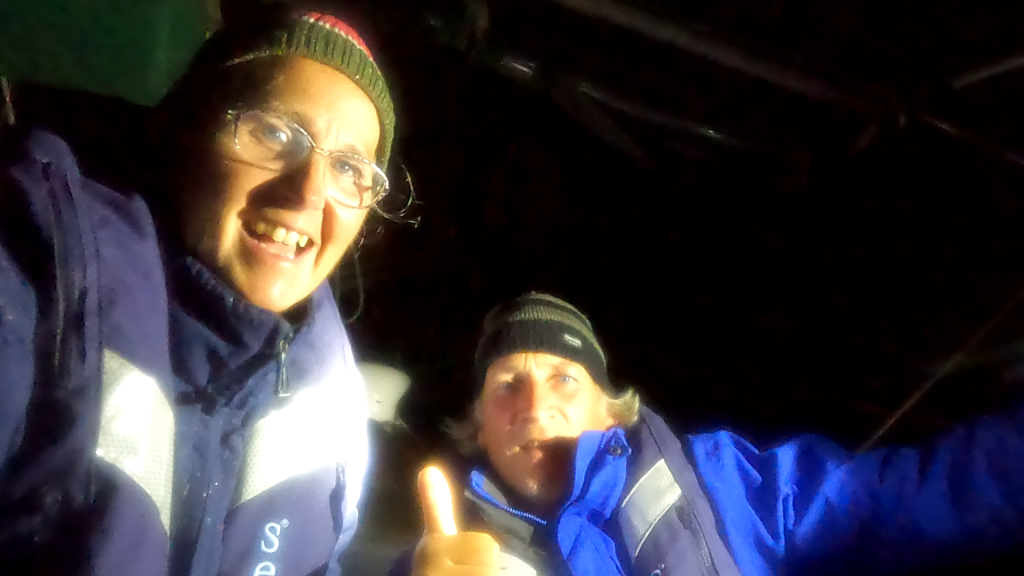
Wildlife
On the first day, Emerald was constantly surrounded by swooping and swirling shearwaters. They’re so elegant in the air and provided a welcome distraction from the wind and waves.
During the first night something startled us as it hit the deck just in front of the sprayhood. A frantic flapping followed, and as we shone a torch, the panicked face of a shearwater appeared in the beam. The poor thing had either been sleeping and got washed aboard by a wave, or simply flew into us.
We wondered what to do – we were in big seas at the time and leaving the safety of the cockpit seemed risky. But after a minute or so, the bird managed to sort itself out, leaving a huge pile of poo behind in its wake.
It wasn’t the only creature that washed aboard. Whilst working on the bow Colin saw a small squid had landed on the deck. I thought, ooh lunch, but it had already started baking on to the deck and Colin had to peel it off before throwing it back to the sea.
The wildlife highlight was spotting a turtle swimming by. To look out at the exact moment in the vastness of the ocean and see this speck paddling by, was awesome. Such a tenacious creature, it was humbling.
No Orcas
Other than birds, a turtle and a dead squid, we didn’t see any other creatures. The night before departure we read that orcas had been sighted off of Sagres. This was the area we’d be sailing through. We’d been monitoring the reports of orca attacks in the Gibraltar Straits: had they now moved west? The orcas seem to enjoy bashing against a yacht’s rudder, and have caused significant damage to some of them. How ironic it would be to be sent back to the boatyard by an orca having only just escaped the yard a few weeks ago! But, luck was on our side and we passed through the area without any sighting of them.
Summary of Our Sail to Porto Santo
Emerald handled the initially bouncy conditions like a pro. At times like that, we’re glad to have our solid, heavy yacht. Her centre cockpit design meant we were spared the worst of any movement and the large space allowed us to sleep comfortably there.
How about us? On the first day, we started talking about what we’d do if we weren’t sailing. Don’t worry, this is a common conversation between us in times of sailing unpleasantness! By the second day as conditions calmed down, we were starting to enjoy elements of the passage. On day 3 I was ready to consider a longer passage. To give you context – I’m not living this life for the sailing, but for several other reasons. These include having the ability to travel with our home and to live frugally and sustainably. It’s not that I don’t enjoy the sailing, more that sometimes I find it dull, with too much sitting around.
So, the thought of a long passage had previously filled me with mild dread. Not because I was afraid of the risks but because I wouldn’t be able to go to land for so long. Now I was coming around. I imagine there would be periods of boredom on a longer passage, but the reward at the end could make the downsides worthwhile. I certainly felt a huge sense of achievement that together we’d sailed our own boat through some challenging conditions to Porto Santo. Plus, arriving under our own steam at an interesting place to explore was a big bonus too. So, we shall see!
Sailing Info
To read the posts made while on passage, click here for day one, and here for day two.
25th June 2022: Sagres to Porto Santo Island – 436nm travelled (of which 435nm were sailed)
28th June 2022: Arrival in Porto Santo
Average speed: 6kts
Weather: Wind mainly from the N F5 to F6, with higher gusts. Backing NE and easing slightly on the afternoon of day 2. Mostly dry with a few spits of rain on day 3.
The Social Media Bit: Want to Follow Us?
If you’d like to follow us on other social media platforms (Facebook, Instagram and YouTube), you can do so by using these links:
Or use the link below to track our voyage on NoForeignLand.com.
And finally, you can sign up to receive email notifications of new blogs using the subscribe box at the bottom of this page.
Thank you from Nichola & Colin



Great sail guys. Well done in meeting the challenges and adding more skills and experiences to your sailing resume. Hope you get the engine sorted soon and are able to focus on exploring. All the best from your sister boat Spirit of Argo.
Thank you southern buddies!
it is a cheep place to haul out. if you need to.
We’re on the waiting list. Hopefully the wait isn’t too long
Pingback: A Sailboat With a Broken Engine - Yacht Emerald